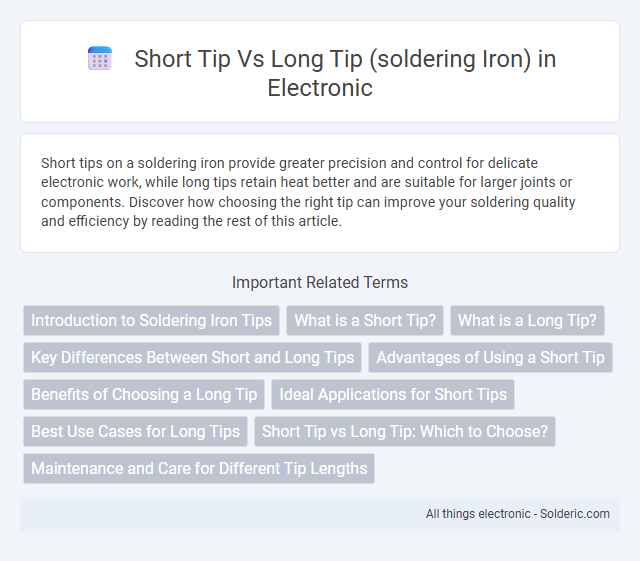Short tips on a soldering iron provide greater precision and control for delicate electronic work, while long tips retain heat better and are suitable for larger joints or components. Discover how choosing the right tip can improve your soldering quality and efficiency by reading the rest of this article.
Comparison Table
| Feature | Short Tip | Long Tip |
|---|---|---|
| Heat Transfer | Faster, efficient heat delivery | Slower heat transfer due to length |
| Precision | High precision for small components | Less precise, better for larger areas |
| Accessibility | Limited reach, tight spaces | Better access to deep or hard-to-reach spots |
| Durability | More robust, less prone to bending | Prone to bending or damage |
| Typical Use | Fine electronics, circuit boards | Wiring, larger joints, mechanical tasks |
Introduction to Soldering Iron Tips
Short soldering iron tips provide precise heat application ideal for delicate electronics and fine joints, while long tips offer greater reach and heat distribution for larger components and circuit boards. Your choice depends on the size and complexity of the soldering task, ensuring efficient heat transfer and minimizing the risk of damaging sensitive parts. Understanding the differences helps optimize soldering performance and accuracy in your projects.
What is a Short Tip?
A short tip on a soldering iron is a compact, stubby tip designed for precision work in tight spaces and on small electronic components. Its reduced length allows for better control and rapid heat transfer, making it ideal for intricate soldering tasks such as surface mount devices (SMD) and delicate circuit board repairs. The short tip's robust thermal performance ensures efficient heat delivery while minimizing the risk of damaging adjacent components.
What is a Long Tip?
A long tip on a soldering iron is designed to reach into tight or recessed areas, providing extended reach and precision for detailed soldering work. It allows for better access to components situated deep within electronics or densely packed circuit boards. Choosing the right tip length is essential for improving your soldering accuracy and efficiency.
Key Differences Between Short and Long Tips
Short soldering iron tips provide precise heat application ideal for delicate electronics and tight spaces, while long tips offer extended reach and better heat distribution suited for larger components and soldering tasks. The thermal mass of longer tips tends to maintain temperature stability, whereas short tips heat up and cool down more quickly, impacting efficiency. Choosing between short and long tips depends on the required precision and component size in soldering projects.
Advantages of Using a Short Tip
A short tip on a soldering iron offers greater precision and control, making it ideal for fine, detailed work on small components or circuit boards. Its compact size allows for faster heat transfer to targeted areas, improving soldering efficiency and reducing the risk of damaging nearby parts. Additionally, short tips cool down quickly, enhancing safety and allowing for more rapid tool changes during complex assembly tasks.
Benefits of Choosing a Long Tip
Long soldering iron tips provide enhanced reach and precision, especially when working on intricate or densely packed electronic components, allowing you to access tight spaces that short tips cannot. They distribute heat more evenly over larger surface areas, reducing the risk of damaging sensitive parts and ensuring stronger solder joints. Your projects benefit from improved control and adaptability, making long tips ideal for detailed circuit board repairs and complex assembly tasks.
Ideal Applications for Short Tips
Short soldering iron tips provide precise heat application, making them ideal for intricate tasks like surface mount device soldering, small component work, and fine circuit board repairs. Their compact size enables better control and access to tight spaces, reducing the risk of damaging adjacent components. When your project requires high accuracy and delicate handling, short tips deliver superior performance and finesse.
Best Use Cases for Long Tips
Long tips on soldering irons excel at providing extended reach and better heat transfer for intricate or deep-set components on circuit boards. They are ideal when accessing tight spaces or working with larger connectors that require consistent, controlled heating without damaging surrounding parts. Your precise control benefits from the stability and durability that long tips offer during complex soldering tasks.
Short Tip vs Long Tip: Which to Choose?
Short soldering iron tips offer precise control and are ideal for delicate electronics work, enabling accurate heat application in tight spaces. Long tips provide better heat retention and reach, making them suitable for soldering larger components or thicker wires. Selecting the right tip depends on the specific task and component size, ensuring efficient soldering performance and preventing damage.
Maintenance and Care for Different Tip Lengths
Short soldering iron tips require frequent cleaning and re-tinning to prevent oxidation due to their smaller surface area, ensuring precise heat transfer and longevity. Long tips, while offering greater reach, need careful temperature control and occasional reshaping to maintain efficiency and avoid damage. Both tip lengths benefit from proper storage and regular inspection for wear, which helps sustain optimal soldering performance and durability.
short tip vs long tip (soldering iron) Infographic

 solderic.com
solderic.com